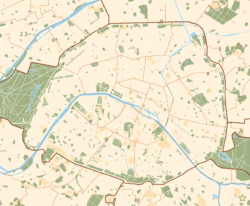- Musée du Vin
-
For other places with the same name, see Wine Museum.
Coordinates: 48°51′27″N 2°17′05″E / 48.8574725°N 2.2846858°E
Musée du Vin Paris
(Wine Museum of Paris)Established 1984 Location 5, Square Charles Dickens, Musée du Vin 75016 Paris, France Type Corkscrews
Wine production
Harvest the grapes
Wine tasting cup
Ancient Wine bottles
Cooperage
Oenology
PotteryVisitor figures 22,100 (2008)
21,700 (2007)
19,300 (2006)Director Mathieu Josse Curator Jean-Jacques Hervy Public transit access Passy Station 

Website www.museeduvinparis.com The Musée du Vin Paris (in English: Wine Museum of Paris) is a cultural venue in the 16th arrondissement located at 5, square Charles Dickens, Paris, France next to the Trocadéro and the Eiffel Tower.[1] The nearest métro station is Passy.
Contents
Overview
The museum opened in 1984, and testifies to the richness and diversity of the French craft of winemaking through an exposure to tools and objects used to work the grapevine and the wine. The collection is showed in an old setting used in the Middle Ages and arranged later in storerooms by the Tiny Brothers of the Convent of Passy.
History
Formerly, the hill where the winding galleries of the Wine Museum are located was covered by vast oak forest. Around the 6th century is growing on the heights of Chaillot Nigeon village, with its crops, vineyards and quarries.[clarification needed]
From 1493, monks settled here. The area of this community then extends to the present Water Street (rue des eaux). The building of the Abbaye de Passy began. The monks cultivated a few acres in a closed street which reminds vinous existence today.[clarification needed] In the hill, they discovered ancient quarries where they created the cellars of the Abbey.
From the 17th century, the street is open water and allows visitors to access the Museum. The name of this street refers to the mineral springs found there and was in great vogue until 1785. Today, visitors can look through a shaft flash. The French Revolution of 1789 removed the religious orders in 1790 and terminated the life of the Abbey, which was gradually destroyed. Rediscovered a few years ago, the Wine Museum opened to the public in 1984.
Description
The wine museum is located in old quarries of the Middle Ages, which were used as cellars in the 15th century. The brothers of the convent of the Minims (Passy) then produced a very popular wine of King Louis XIII, from the wine harvest of the hillsides of the Seine. The "Rue des Eaux", which currently serves on the museum takes its name from the discovery in the 17th century hot springs that have been exploited for 200 years. The wine museum is owned by the Conseil des Echansons de France since 1984, a winebrotherhood gathering Amateur Wine purists in France and abroad, and aimed through the museum to "defend and promote the best wines of appellation of french origin" ("appelation d'origine controlée")., December 2010
Features
Rehabilitated after 1950, the former cellars of the convent of Minims served time in the cellar restaurant of the Eiffel Tower before becoming the Wine Museum, owned since 1984 the Conseil des Echansons de France. The Winebrotherhood, founded in 1954, aims to defend and promote best appellations of French terroirs. To this end, it organizes in France, abroad and in this museum, many prestigious events. It gathers around the world many thousands of professionals and amateurs who ensure the retention of expertise and quality that make the world-famous French wines. The "Conseil des Echansons de France" runs the museum offers to the public on the subject of the vine and wine, a wide range of cultural activities and events, visit the galleries where his collections are exposed. The collection is presented in the galleries beneath the hill of Passy.
Collection
A rich collection of more than 2,000 pieces is presented on the tools of viticulture, winemaking and wine tasting. The oldest of them date back a century before Jesus Christ to the most recent of the 19th century. The wax figures, as some historical Napoléon, Pasteur or Balzac, depict objects in the collection.
In France, more than two thousand years of expertise led to the development of world-famous wines. Generations of winemakers, master chairs, coopers and wine experts have continued to refine their techniques to produce the most prestigious wines. This exhibition pays tribute to evoke their professions. It offers visitors the opportunity to recognize or discover traditional tools, sometimes quirky, often overlooked, which are now part of French heritage. Many in fact are no longer used and are now kept in private collections and museums. They show, for generations to come, the ingenuity of their inventors and the skill of those who mastered its use.
The content of the exhibition includes:
- The tools of the vine
- The wine cellar
- Cooperage
- Wine and oenology
- Objects to serve and taste wine
- The traditions of the land
See also
References
External links
- Musée du Vin Paris website
- Musée du Vin Paris (French)
- Wine Museum of Paris (English)
Categories:- Museums established in 1984
- Museums in Paris
- Food museums in France
- Wine museums
- 16th arrondissement of Paris
Wikimedia Foundation. 2010.



